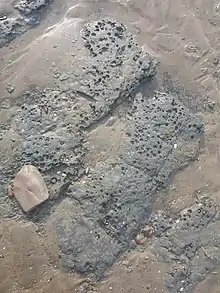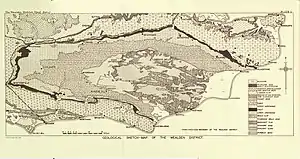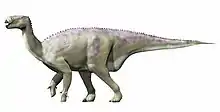Weald Clay
Weald Clay or the Weald Clay Formation is a Lower Cretaceous sedimentary rock underlying areas of South East England, between the North and South Downs, in an area called the Weald Basin It is the uppermost unit of the Wealden Group of rocks within the Weald Basin, and the upper portion of the unit is equivalent in age to the exposed portion of the Wessex Formation on the Isle of Wight. It predominantly consists of thinly bedded mudstone.[1] The un-weathered form is blue/grey, and the yellow/orange is the weathered form, it is used in brickmaking.

| Weald Clay Stratigraphic range: Hauterivian-Barremian, 136–125 Ma | |
|---|---|
 Bored exposure of the lower Weald Clay on the shore near Cooden Beach | |
| Type | Geological formation |
| Unit of | Wealden Group |
| Sub-units | Horsham Stone Member |
| Underlies | Atherfield Clay Formation |
| Overlies | Tunbridge Wells Sand Formation |
| Thickness | up to 460 m |
| Lithology | |
| Primary | Shale, Mudstone |
| Other | Siltstone, Sandstone, Limestone, Ironstone |
| Location | |
| Region | England |
| Country | |
| Type section | |
| Named for | Weald |
 Extent of the Weald Clay within the Weald Basin, shown with horizontal lines | |
The formation was deposited in lagoonal, lacustrine and alluvial conditions that varied from freshwater to brackish.[2] The clay alternates with other subordinate lithologies, notably hard red-weathering beds of ironstone, limestone (Sussex Marble) and sandstones, notably including the calcareous sandstone unit referred to as the Horsham Stone. It has a gradual, conformable contact with the underlying Tunbridge Wells Sand Formation, and has a sharp, unconformable contact with the overlying Atherfield Clay Formation, a shallow marine unit deposited after marine transgression during the Aptian.
Physical properties
The weathered and unweathered forms of the Weald Clay have different physical properties. Blue looks superficially like a soft slate, is quite dry and hard and will support the weight of buildings quite easily. Because it is quite impermeable, and so dry, it does not get broken by tree roots. It is typically found at 750mm down below a layer of yellow clay. Yellow, found on the surface, absorbs water quite readily so becomes very soft in the winter. The two different types make quite different bricks.
Paleofauna
Vertebrates
| Vertebrates reported from the Weald Clay | ||||||
|---|---|---|---|---|---|---|
| Genus | Species | Location | Stratigraphic position | Material | Notes | Images |
|
B. walkeri |
Smokejack Clay Pit | Upper Weald Clay |
Multiple partial skulls, one of which had an associated postcranial skeleton.[3] |
A spinosaurid, also known from the Wessex Formation |
| |
|
H. rudgwickensis |
Rudgwick Brickworks | Upper Weald Clay |
"Vertebrae, partial fore and hindlimbs, osteoderms."[4] |
An ankylosaur belonging to Polacanthinae. Originally named as a species of Polacanthus.[5] |
||
| Iguanodon | I. bernissartensis | Smokejack Clay Pit | Upper Weald Clay | Iguanodontian, also known from the Wessex Formation. |
| |
| Mantellisaurus | M. atherfieldensis | Smokejack Clay Pit | Upper Weald Clay | Iguanodontian, also known from the Wessex Formation |
| |
|
V. canaliculatus[6] |
Heathfield | Lower Weald Clay |
A dryosaurid, also known from the Wessex Formation |
|||
| Leptocleidus | L. superstes[7] | NHM R4828 (holotype) | Pliosauroid |
| ||
| Wyleyia[8] | W. valdensis[8] |
|
||||
| Dorsetisaurus | Indeterminate | Keymer Tile Works | ||||
| Sauropoda | Indeterminate | Smokejacks, Bexhill | ||||
| Anura | Indeterminate | Keymer Tile Works | Lower | Maxillary fragment[9] | ||
| Urodela | Indeterminate | Keymer Tile Works | Lower | Atlas vertebra | Has been suggested to have a close relationship with Balveherpeton from Germany.[10] | |
Invertebrates
Numerous insect species are known from several localities in the Weald Clay, including Rudgwick Brickworks,[11] Auclaye Brickworks,[12] Smokejacks [13] and Clockhouse Brickworks[14][15][16]
| Invertebrates reported from the Weald Clay | ||||||
|---|---|---|---|---|---|---|
| Genus | Species | Location | Stratigraphic position | Material | Notes | Images |
| Principiala[17] | P. rudgwickensis | Rudgwick Brickworks | Upper Weald Clay | Single partial fore-wing | An Ithonidae lacewing, the second in Principiala | |
| Englathauma | E. crabbi | Rudgwick Brickworks | BMB 021962/3 almost complete forewing | A englathaumatid scorpionfly | ||
| E. mellishae | Smokejacks | Wing and wing fragments | ||||
| Cretophasmomima[18] | C. traceyae | Smokejacks | Forewing | A stick insect | ||
| Valdicossus | V. mikewebsteri[19] | Smokejacks | Upper | Hindwing | A member of Palaeontinidae | |
| V. chesteri[20] | Cooden Beach | Lower | Hindwing | |||
| Ilerdocossus | I. prowsei [19] | Clockhouse Brickworks | Lower | A member of Palaeontinidae | ||
| Proraphidia | P. hopkinsi[21] | A member of Mesoraphidiidae | ||||
| Turanophlebia | T. anglicana[22] | Dragonfly, member of Tarsophlebiidae | ||||
| Brochocoleus | B. keenani[23] B. tobini | Smokejacks | Upper | Member of Ommatidae | ||
| Diluticupes | D. crowsonae | |||||
| Zygadenia | Z. tuberculata,[24] Z. angliae[25] | |||||
| Cionocoleus | C. elizabethae, C. watsoni [26] C. minimus | |||||
| Omma | O. elongatum | Keymer Tile Works | Lower | |||
See also
- Wealden District
- London Clay
- Oxford Clay
- List of dinosaur-bearing rock formations
Footnotes
- "Wealden Clay Formation". The BGS Lexicon of Named Rock Units. British Geological Survey. Retrieved 14 December 2014.
- Radley, Jonathan D (June 1999). "Weald Clay (Lower Cretaceous) palaeoenvironments in south-east England: molluscan evidence". Cretaceous Research. 20 (3): 365–368. doi:10.1006/cres.1999.0156.
- "Table 4.1," in Weishampel, et al. (2004). Page 72.
- "Table 17.1," in Weishampel, et al. (2004). Page 367.
- Blows, W.T., 2015, British Polacanthid Dinosaurs – Observations on the History and Palaeontology of the UK Polacanthid Armoured Dinosaurs and their Relatives, Siri Scientific Press, 220 pp.
- Galton, P.M., 2009, "Notes on Neocomian (Late Cretaceous) ornithopod dinosaurs from England - Hypsilophodon, Valdosaurus, "Camptosaurus", "Iguanodon" - and referred specimens from Romania and elsewhere", Revue de Paléobiologie 28(1): 211-273
- "Reassessment of the Lower Cretaceous (Barremian) pliosauroid Leptocleidus superstes Andrews, 1922 and other plesiosaur remains from the nonmarine Wealden succession of southern England | Oxford Academic". academic.oup.com. Retrieved 2017-11-16.
- "10.18 West Sussex, England; 1. Hastings Beds" in Weishampel, et al. (2004). Page 559.
- Sweetman, S.C; Evans, S. E. (2011). "Lissamphibians (frogs, salamanders and albanerpetontids)". English Wealden fossils. Palaeontological Association. ISBN 978-1-4443-6711-9. OCLC 777385514.CS1 maint: multiple names: authors list (link)
- Skutschas, Pavel P.; Kolchanov, Veniamin V.; Schwermann, Achim H. (December 2020). "First salamander from the Lower Cretaceous of Germany". Cretaceous Research. 116: 104606. doi:10.1016/j.cretres.2020.104606.
- "Rudgwick Brickworks, Upper Weald Clay (Cretaceous of the United Kingdom)". fossilworks.org. Retrieved 2020-01-26.
- "Auclaye Brickworks (BMB collection) (Cretaceous of the United Kingdom)". paleobiodb.org. Retrieved 2020-01-26.
- "Smokejacks Brickworks (Cretaceous of the United Kingdom)". paleobiodb.org. Retrieved 2020-01-26.
- "Clockhouse Brickworks (MNEMG collection) (Cretaceous of the United Kingdom)". fossilworks.org. Retrieved 2020-01-26.
- "Clockhouse Brickworks (BMNH collection) (Cretaceous of the United Kingdom)". fossilworks.org. Retrieved 2020-01-26.
- "Clockhouse Brickworks (BMB collection): Late/Upper Hauterivian, United Kingdom". paleobiodb.org. Retrieved 2020-01-26.
- Jepson, JE; Makarkin, VN; Jarzembowski, E (2009). "New lacewings (Insecta: Neuroptera) from the Lower Cretaceous Wealden supergroup of Southern England". Cretaceous Research. 30 (5): 1325–1338. doi:10.1016/j.cretres.2009.07.012.
- Xu, Chunpeng; Jarzembowski, Edmund A.; Fang, Yan (January 2020). "A new stick insect (Phasmatodea: Susumanioidea) from the Lower Cretaceous Wealden Group of southern England". Cretaceous Research. 112: 104387. doi:10.1016/j.cretres.2020.104387.
- Li, Yuling; Jarzembowski, Edmund; Chen, Jun; Wang, Bo (March 2019). "New Palaeontinidae (Insecta: Hemiptera) from the Lower Cretaceous of southern England". Cretaceous Research. 95: 297–301. doi:10.1016/j.cretres.2018.11.019.
- WANG, BO; ZHANG, HAICHUN; JARZEMBOWSKI, EDMUND A. (2008-04-16). "A new genus and species of Palaeontinidae (Insecta: Hemiptera: Cicadomorpha) from the Lower Cretaceous of southern England". Zootaxa. 1751 (1): 65. doi:10.11646/zootaxa.1751.1.7. ISSN 1175-5334.
- J. E. Jepson and E. A. Jarzembowski. 2008. Two new species of snakefly (Insecta: Raphidioptera) from the Lower Cretaceous of England and Spain with a review of other fossil raphidiopterans from the Jurassic/Cretaceous transition. Alavesia 2:193-201
- G. Fleck, G. Bechly, X. Martínez-Delclòs, E. A. Jarzembowski, and A. Nel. 2004. A revision of the Upper Jurassic-Lower Cretaceous dragonfly family Tarsophlebiidae, with a discussion on the phylogenetic positions of the Tarsophlebiidae and Sieblosiidae (Insecta, Odonatoptera, Panodonata. Geodiversitas 26(1):33-59
- Jarzembowski, Edmund A.; Yan, Evgeny V.; Wang, Bo; Zhang, Haichun (August 2013). "Brochocolein beetles (Insecta: Coleoptera) from the Lower Cretaceous of northeast China and southern England". Cretaceous Research. 44: 1–11. doi:10.1016/j.cretres.2013.03.003. ISSN 0195-6671.
- Jarzembowski, Edmund A.; Wang, Bo; Zhang, Haichun; Fang, Yan (January 2015). "Boring beetles are not necessarily dull: New notocupedins (Insecta: Coleoptera) from the Mesozoic of Eurasia and East Gondwana". Cretaceous Research. 52: 431–439. doi:10.1016/j.cretres.2014.03.006. ISSN 0195-6671.
- A. G. Ponomarenko. 2006. On the Types of Mesozoic Archostematan Beetles (Insecta, Coleoptera, Archostemata) in the Natural History Museum, London. Paleontological Journal 40(1):90-9
- E. A. Jarzembowski, E. V. Yan, B. Wang and H. Zhang. 2013. Ommatin beetles (Insecta: Coleoptera) from the Lower Cretaceous of northeast China and southern England. Terrestrial Arthropod Reviews 6:135-161
References
- Weishampel, David B.; Dodson, Peter; and Osmólska, Halszka (eds.): The Dinosauria, 2nd, Berkeley: University of California Press. 861 pp. ISBN 0-520-24209-2.



